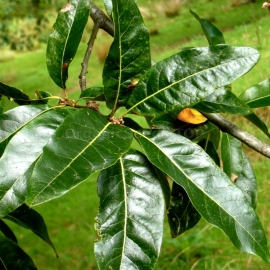






Organic Shingle Oak Seeds (Quercus Imbricaria)
1.14 €
Rare in the east, abundant in the lower Ohio valley and middle of Mississippi valley. Reaches its largest size in southern Illinois and Indiana. Bark: Light brown, scaly; on young stems light brown, smooth.
-
Organic Shingle Oak (Quercus Imbricaria)
A tree usually fifty to sixty feet high, maximum height one hundred, with broad pyramidal head when young, becoming in old age broad-topped and open.
Rare in the east, abundant in the lower Ohio valley and middle of Mississippi valley. Reaches its largest size in southern Illinois and Indiana. Bark: Light brown, scaly; on young stems light brown, smooth. Branchlets slender, dark green and shining at first, later become light brown, finally dark brown. Wood: Pale reddish brown, sapwood lighter; heavy, hard coarse-grained, checks badly in drying; used for shingles and sometimes in construction.
Winter buds: Light brown, ovate, acute, one-eight inch long. Leaves: Alternate, oblong or obovate, four to six inches long, one to two inches wide, wedge-shaped or rounded at base, acute or rounded at apex, sometimes entire or with undulated margins, sometimes more or less three-lobed. They come out of the bud involute, bright red, covered with rusty down above and white tomentum below.
When full grown are dark green, smooth and shining above, pale green or pale brown, downy below; midribs stout yellow, grooved above, primary veins slender. In autumn they become dark red above, pale beneath, midribs darken, then the leaf. Petioles stout, hairy, flattened, grooved. Stipules about one-half inch long, caducous.
Flowers: May, when leaves are half grown. Staminate flowers borne on tomentose aments two to three inches long. Bracts linear-lanceoate. Calyx pale yellow, downy, four-lobed; stamens four to five; anthers yellow. Pistillate flowers borne on slender tomentose peduncles. Involucral scales are downy, about as long as the calyx lobes; stigmas short, reflexed, greenish-yellow.
Acorns: Ripen in autumn of second year; stalked, solitary or in pairs; nut almost spherical, one-half to two-thirds inch long; cup embraces one-half to two-thirds nut, is cup-shaped covered with light red brown, downy scales, rounded or acute at apex. Kernel very bitter.
